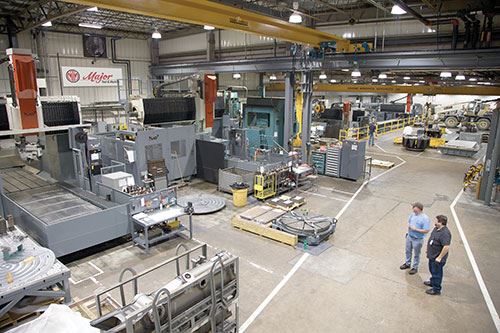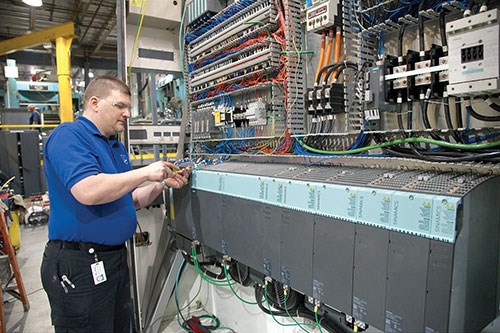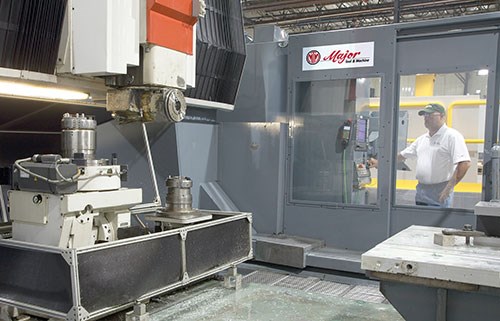New control interfaces and programming capabilities can make old equipment feel new again, but taking full advantage of modern CNC technology usually requires a more substantial retrofit. In fact, simply swapping an outdated or non-functioning CNC for a new model isn’t even an option in some cases.
So says Doug Huber, who has been involved with more than 150 CNC machine tool retrofits during his 25 years with automation services provider
Indiana Automation. He explains that the individual elements of modern motion control systems are too closely integrated to consider any one component in isolation. Beyond that, manufacturers concerned only with getting a machine up and running again might miss out on opportunities for more dramatic improvements.
To help make this case, he cites the experience of Major Tool & Machine (MTM), a 500,000-square-foot contract manufacturer in Indianapolis, Indiana that certainly didn’t miss out on any opportunities when it began a series of retrofits in 2010. The project started with four Cincinnati U5 machining centers: two bridge models and two gantry-types. When Mr. Huber and his team completed their work, this equipment sported not only new CNCs, drives and motors, but also brand new capabilities that changed the very nature of how they’re operated.
Old Iron, New Capabilities
MTM’s U5s are typical of the sort of machines that Mr. Huber views as prime candidates for retrofitting—large, complex equipment that is too important to jettison and too expensive to replace outright. The shop’s massive five-axis mills are tasked with producing a variety of mission-critical, often one-off components for aerospace, nuclear and defense projects. Given that role, primary goals for the retrofit included improving not only performance, but also machining flexibility.
To that end, the company decided to standardize on the
Siemens CNC platform to ensure trainees and seasoned operators alike could easily move from machine to machine. Other benefits of the new platform include the ability to write macros and enter job parameters into the Sinumerik interface of the machines’ new 840D CNCs, which proved far easier than G-code programming. Operators can also program certain parts on the shop floor rather than offline. Plus, part and tool probing capabilities help manage frequent change-overs.
A Complete System
Despite the advantages of these control-specific features, it became clear at the very outset that simply replacing the machines’ CNCs wouldn’t be sufficient to meet the company’s goals. In fact, it wouldn’t even be an option. Mr. Huber explains that the U5 machines’ drive systems simply wouldn’t be compatible with the 840Ds—or any modern control, for that matter. Although they’re approximately 15 years old, the five-axis mills still hail from an era when digital drive systems had already become the norm among machine tool builders. Unlike their analog counterparts, these systems employ signal interfaces that are unique to specific suppliers. Moreover, CNCs and digital drives typically need to be from the same general era to be compatible because suppliers periodically upgrade these interfaces.
Manufacturers seeking retrofits on analog machines have more flexibility. For instance, a CNC upgrade alone might be the best solution for an analog machine tasked with less-demanding work—especially on a limited budget or timeframe. In that case, CNC-specific programming features like those of MTM’s new 840Ds would be an added benefit. “Sometimes the main thing is to keep a machine running, even if you don’t get performance advances,” Mr. Huber says. “It often comes down to cost.”
Still, given sufficient foresight and financial resources, a company like MTM would have reason to consider a more substantial retrofit even if a mere CNC swap were a viable option. One reason Mr. Huber cites is that anything less than a total upgrade can limit the potential benefits of a retrofit. For example, MTM’s new 840Ds offer faster block processing than previous controls. However, the resulting cycle time gains likely wouldn’t be as significant with the machines’ original drives, which simply couldn’t accelerate or decelerate as smoothly as newer models.
Other advantages would be sacrificed entirely. Consider the 840D’s ability to tune axis servomotors automatically for individual applications. In part, this is possible because both the positioning loop, which determines where an axis travels, and the velocity loop, which determines the parameters of motion, are closed within the control, Mr. Huber says. In contrast, older systems that isolate the velocity loop to the servomotors themselves require manual tuning. This process is not only time-consuming, but also commonly involves setting parameters to a “happy medium” intended to provide sufficient productivity while still accommodating worst-case scenarios, such as a particularly heavy part that significantly alters motion dynamics. That inherently limits the machine’s capacity for precision and speed.
In addition to limiting the benefits of a retrofit, pairing the old with the new can cause additional problems in some cases. For instance, modern CNCs can be less forgiving of worn ballscrews, bearings, way surfaces and other positioning elements, all of which MTM closely evaluated and replaced where necessary. Another problem that can potentially cause uneven motion is when the CNC is too fast to respond properly to older feedback devices with limited resolution—as Mr. Huber describes it, the CNC might “read in between the bursts of feedback” returning to it. At MTM, this was one concern with a large vertical lathe that often runs at low rpm to enable effective machining toward the edges of the table, where surface speed is still substantial.
A Major Revamp
Another notable aspect of MTM’s retrofit strategy was the company’s drive to make the most of its time while machines were down. “MTM was pulling gearboxes apart, replacing bearings, replacing cable carriers, cleaning—when we were done, they were like brand new machine tools,” Mr. Huber says. The company also took the opportunity to replace various ancillary control features, such as motor starters for coolant pumps, hydraulics and so forth. While most of these systems still operated fine, newer, more reliable systems limit the risk of having to interrupt production to replace them later. Another upgrade, which Mr. Huber says is quite common among his customers, was the installation of remote I/O racks that reduce clutter caused from lengthy sections of wiring linking the control panel to sensors, limit switches and other components in the machine’s electrical enclosure.
The retrofit also provided the opportunity to add capabilities beyond those inherent to a new control and motion system. For example, some machines now feature higher-horsepower spindles, and others are equipped with tool and part probing capabilities that greatly help manage changeovers from job to job. More notably, the U5s can now accept three different types of machining head: a straight model for heavy cuts, a contouring configuration for five-axis work and a 90-degree head for anything in between. Each has its own configuration file complete with all required settings and parameters. Along with head-storage and tool management programming provided by the Siemens CNC platform, this enables swapping heads from machine to machine on-the-fly without spending inordinate amounts of time reconfiguring axes and zero positions. “When you mount a different head, the control just runs the configuration file that goes with it, and it’s all set up for you,” Mr. Huber explains. The company can exchange rotary tables the same way, he adds. The flexibility provided by these modifications has drastically changed the company’s approach to production on the U5 machines.
The takeaway from MTM’s retrofit approach is twofold. First, a total motion system upgrade is not only advisable in most cases, but is often necessary to push a machine beyond its original performance levels. Second, breaking down any piece of equipment is an ideal occasion to perform tuning, cleaning and other maintenance procedures, as well as to add new capabilities.
Credit: Photos courtesy of Siemens Industry, Inc.






























